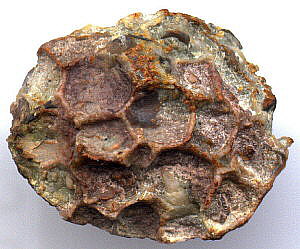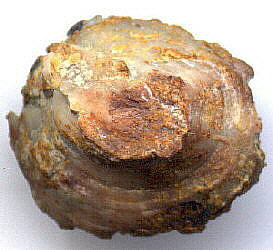Michelinia
sp.
Class Tabulata (coral)

Top and Bottom views
General abundance: Common
Michelinia is
a tabulate coral in the family Favositidae.
The left view shows the numerous subcircular calices, and
the right view shows the underside of the coral where it
was possibly attached to a crinoid stem. I have specimens
that are attached to crinoid stems.
Pleurodictyum and the Michelinia appeared to me to be the same
coral. I
asked Alan Goldstein and Dr. Yancey for their comments.
According to the Treatise (vol. F corals), Michelinia
ranges from
L. Devonian - Permian. Therefore your coral can't be Pleurodictyum
and must be Michelinia. Incidentally, there are several unique michelinid
corals found in Missouri, including Beaumontia, Conopoterium
(Louisiana Limestone) and ?Tabellaephyllum (Chouteau Limestone).
Alan Goldstein
The corals you have are fairly common in Carboniferous mud-bottom
environments, but are largely undescribed. The elevated shape of the
corals is a result of life in a mud bottom environment. The larvae
settled on shells and then grew larger and upward as more mud
accumulated on the seafloor. For corals, the shape of the colony is
determined almost entirely by the immediate environment - this is
called eco-phenotypic growth form. If a coral settled on a rock
outcrop or on a sand bar, the individual animal would produce a shape
different from that it produces if it settled on a mud bottom. When
we look at a coral, we see a strong tendency for the environment to
control the colony form. For many corals the same species of coral
can occur as a branching form, an irregular form, a rounded
"coral-head" form, or a plate-like form, depending on the site that
the larvae settles on. This is seen in modern and ancient corals and
is known to be the same for many bryozoans and is very common
among stromatoporoids.
These corals are described in the reference listed
below. The coral
work is by J. Cocke, now deceased, and covers assemblages collected
from Kansas, Oklahoma and Texas. This work discusses corals at the
genus level, but is the only comprehensive account available for the
cyclic units.
Dr. Tom Yancey
References:
Cocke, J. M., Boardman, D. R., II, and Mapes, R. H.,
1989,
Stratigraphic distribution and facies control of late Pennsylvanian
coral assemblages in the North American midcontinent, p. 249-278, in
Boardman, D. R. et al., edis., Middle and Late Pennsylvanian
chronostratigraphic boundaries in north-central Texas:
Glacial-eustatic events, biostratigraphy and paleoecology, Part 2:
Contributed Papers, Texas Tech University Studies in Geology 2, 380 p.
Go-Back
Phylum
Cnidaria (corals)
Fossil
Menu
